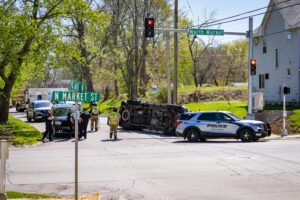Road Diet In Oskaloosa Has Created Controversy And Maybe Fewer Crashes
Lane Diet In Oskaloosa Has Created Controversy And Maybe Fewer Crashes
May 23rd, 2023
Oskaloosa, Iowa – To say that the conversion of A Avenue in Oskaloosa from a 4-lane to a 3-lane has been controversial might be an understatement.
Oskaloosa News recently sat down with Oskaloosa Police Chief Benjamin Boeke to discuss if there are positive results due to the change.
Boeke explained that the road diet plan started getting traction nearly a decade ago and has been discussed more over the past five years.
“I know there’s consternation, there’s some confusion, especially when the paint didn’t work properly,” Boeke explained. “There was definitely some confusion as to how it was supposed to work.”
“This wasn’t just an idea that somebody came up with,” Boeke explained, but it was based upon the available crash data.
When asked about the number of crashes taking place in Oskaloosa, particularly along A Avenue, Boeke said he remembered the conversations about just how many crashes were taking place, and how in other communities the conversion to a three-lane from four-lane had changed how many crashes were taking place.
Oskaloosa had some of the state’s highest crash rates per capita, and the hope was to cut that amount in half.
“They [Iowa DOT] have seen that in different areas,” said Boeke, referencing the crash data from other communities that have also undergone the road diet plan.
“I’m from a larger area where I’m used to a lot of crashes,” said Boeke. “I was shocked how many crashes we were having on A Avenue and a lot of rear-enders, a lot of ones that are just not explainable by anything other than people aren’t paying attention, or they’re confused by the way the road is put together.”
Boeke said he knows that change is hard, ” It’s been this way for as long as anyone can remember. Once you change it, and people start figuring out how it works, the traffic is smoother flowing. That doesn’t mean it’s always more convenient. [It] doesn’t mean things don’t back up once in a while. But the speeds are more consistent, and the traffic flow is generally easier to predict, which calms things, and that’s the idea of this. You’re calming traffic so that there are fewer thought processes that have to happen by drivers, fewer decisions, and then fewer crashes.”
The data shows that the conversion has helped to lower crash rates. Boeke shared the data that shows, at this point, comparing the same time frame year over year, things are improving, with fewer crashes happening along A Avenue.
This then begs the question, are those crashes being moved to side streets as drivers search for alternate routes beyond A Avenue?
Boeke said looking at the data, there needs to be more data since there are typically low numbers of crashes. “After things settle down a little bit, we’ll do a study on it and find out: Are the counts significantly higher, and then are other crashes proportionate with that? Are the crashes still staying pretty consistent?
A benefit for emergency vehicles is having easier access along A Avenue when responding to calls for help. “They [first responders] have to think about the change also and how to navigate that,” Boeke explained.
“We have issues with people; if there’s lights behind them, they freeze up, they don’t remember to curb to the right and get out of the way. We have people that pull into the center lane to try and get out of the way, which mucks up everything,” Boeke said. “So if people are following the rules of the road, which means lights behind you, move to the right and slow down or stop. Then it’s easier for us to navigate through that center lane and try and get to where we need to go.”
“Having a fire truck with that center lane open, is very convenient for them because they’re much larger than our patrol cars, and having a fire truck or an ambulance have to navigate and weave through traffic instead of just having that lane open,” Boeke explained of the benefit for the community.
On the side roads in the community, Boeke addressed traffic counts and speed on those roads.
C Avenue East in Oskaloosa is one of those smaller arteries for traffic, and they posted the speed trailer there to measure traffic and the speed of drivers over 13 days.
They counted 31,000 vehicles on the 25 mph road. The average speed was 25.8 along that stretch of road. The trailer clocked a vehicle at 79 mph along that stretch of road.
We asked if that speed could have been from an emergency vehicle, and Boeke said he doesn’t know. “But I’ll just say, my emergency vehicles, I would not want to see them doing 79 in a residential area in the city, even if it’s an emergency.”
That 79 would turn out to be a low number, as the speed trailer clocked a few other shocking numbers.
Along Green Street, the trailer recorded a driver doing 92 mph in a 25 mph zone.
Along 11th Avenue West, a 35 mph zone had one driver doing 91 mph.
Finally, a driver was clocked at 96 mph along 15th Avenue East in Oskaloosa.
“Definitely, we do have some speed issues,” Boeke said. “We are mostly complaint-driven with where we do our speed enforcement, where we put the speed trailer. We definitely have some speed problems within this community, but it is localized to some individuals.”
You can watch the complete interview for more in-depth information by clicking HERE.











